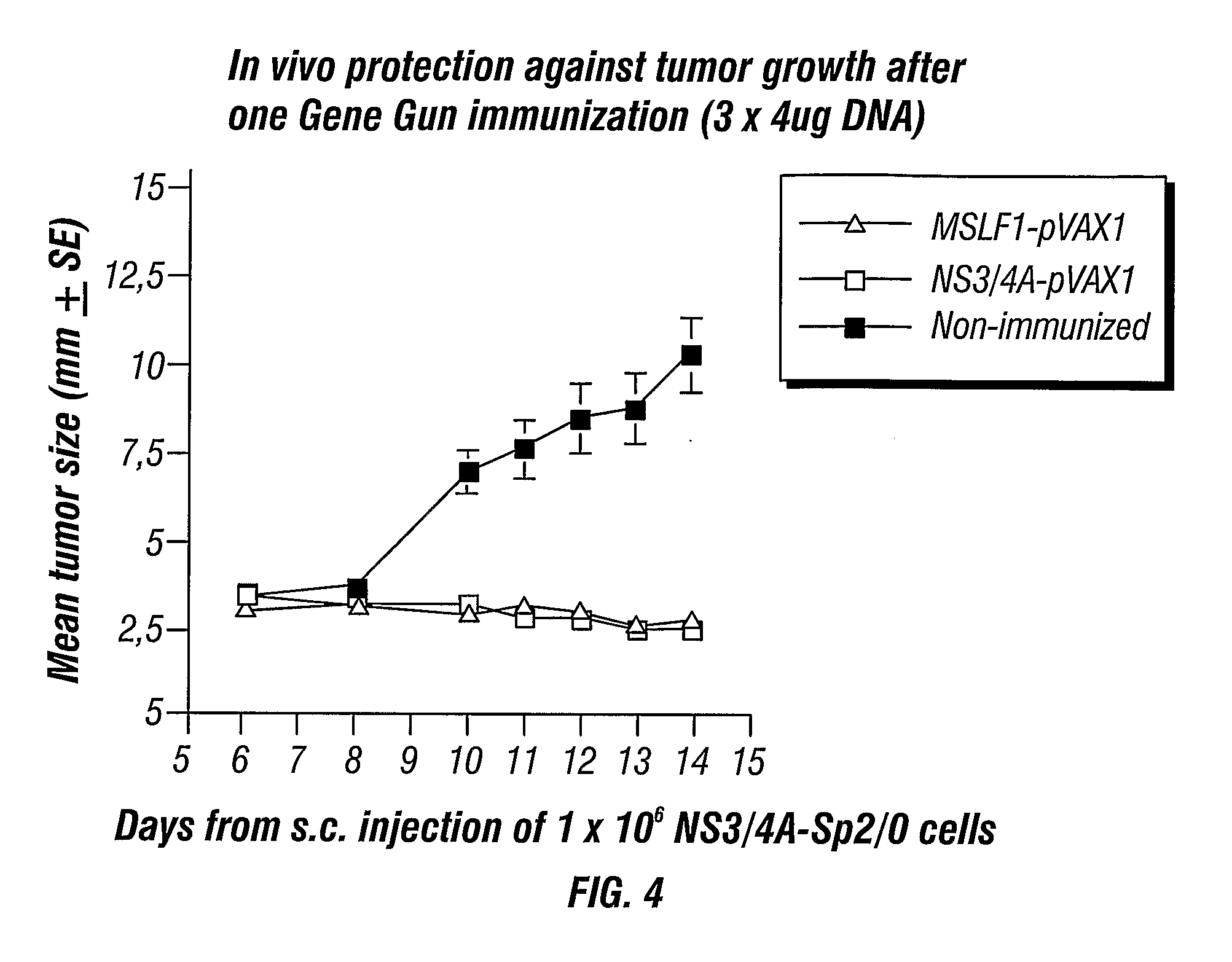Hepatitis c virus non-structural ns3/4a fusion gene
a fusion gene and hepatitis c virus technology, applied in the field of hepatitis c virus non-structural ns3/4a gene, can solve the problems of inability to efficiently present polypeptide sequences, inability to prevent the establishment of chronic diseases, and inability to block the interaction of virus particles with their cellular receptors, etc., to achieve enhanced or facilitate an immune response to hepatitis, and enhance or facilitate an immune response to.
- Summary
- Abstract
- Description
- Claims
- Application Information
AI Technical Summary
Benefits of technology
Problems solved by technology
Method used
Image
Examples
example 1
[0069]The NS3 / 4A sequence was amplified from the serum of an HCV-infected patient (HCV genotype 1a) using the Polymerase Chain Reaction (PCR). Total RNA was extracted from serum, and cDNA synthesis and PCR were performed according to standard protocols (Chen M et al., J. Med. Virol. 43:223-226 (1995)). The cDNA synthesis was initiated using the antisense primer “NS4KR” (5′-CCG TCT AGA TCA GCA CTC TTC CAT TTC ATC-3′ (SEQ. ID. NO.: 28)). From this cDNA, a 2079 base pair DNA fragment of HCV, corresponding to amino acids 1007 to 1711, which encompasses the NS3 and NS4A genes, was amplified. A high fidelity polymerase (Expand High Fidelity PCR, Boehringer-Mannheim, Mannheim, Germany) was used with the “NS3KF” primer (5′-CCT GAA TTC ATG GCG CCT ATC ACG GCC TAT-3′ (SEQ. ID. NO.: 29) and the NS4KR primer. The NS3KF primer contained a EcoRI restriction enzyme cleavage site and a start codon and the primer NS4KR contained a XaI restriction enzyme cleavage site and a stop codon.
[0070]The ampli...
example 2
[0094]To determine whether a humoral immune response was elicited by the NS3-pVAX and NS3 / 4A-pVAX vectors, the expression constructs described in Example 1 were purified using the Qiagen DNA purification system, according to the manufacturer's instructions and the purified DNA vectors were used to immunize groups of four to ten Balb / c mice. The plasmids were injected directly into regenerating tibialis anterior (TA) muscles as previously described (Davis et al., Human Gene Therapy 4(6):733 (1993)). In brief, mice were injected intramuscularly with 50 μl / TA of 0.01 mM cardiotoxin (Latoxan, Rosans, France) in 0.9% sterile NaCl. Five days later, each TA muscle was injected with 50 μl PBS containing either rNS3 or DNA.
[0095]Inbred mouse strains C57 / BL6 (H-2b), Balb / C(H-2d), and CBA (H-2k) were obtained from the breeding facility at Möllegard Denmark, Charles River Uppsala, Sweden, or B&K Sollentuna Sweden. All mice were female and were used at 4-8 weeks of age. For monitoring of humoral...
example 2a
[0101]To test the intrinsic immunogenicity of the different NS3 genes groups of BALB / c (H-2d) mice were immunized with the following vectors: wtNS3 / 4A (wild type NS3 / 4a), coNS3 / 4A (codon-optimized NS3 / 4a or MSLF-1), or wtNS3 / 4A-SFV (wild-type NS3 / 4A obtained from SFV expression). Doses of 4 μg DNA was administered using the gene gun and doses of 107 SFV particles were injected subcutaneously (s.c.). The mice were boosted after four weeks. The mice immunized with the wtNS3 / 4A-SFV developed antibodies already after the first injection suggesting a potent immunogenicity (FIG. 10). At two weeks after the second immunization most mice immunized with the coNS3 / 4A or wtNS3 / 4A-SFV vectors had developed mean antibody levels over 103 (FIG. 10). In contrast, none of the mice immunized with the wtNS3 / 4A plasmid had developed detectable NS3-specific antibodies at six weeks (FIG. 10). Thus, both codon optimization and mRNA amplification by SFV results in an increased B cell immunogenicity of the ...
PUM
| Property | Measurement | Unit |
|---|---|---|
| concentrations | aaaaa | aaaaa |
| pH | aaaaa | aaaaa |
| volume | aaaaa | aaaaa |
Abstract
Description
Claims
Application Information
 Login to View More
Login to View More - R&D
- Intellectual Property
- Life Sciences
- Materials
- Tech Scout
- Unparalleled Data Quality
- Higher Quality Content
- 60% Fewer Hallucinations
Browse by: Latest US Patents, China's latest patents, Technical Efficacy Thesaurus, Application Domain, Technology Topic, Popular Technical Reports.
© 2025 PatSnap. All rights reserved.Legal|Privacy policy|Modern Slavery Act Transparency Statement|Sitemap|About US| Contact US: help@patsnap.com



